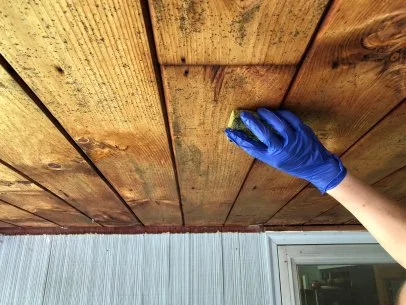When you spot dark patches spreading across your wooden beams, furniture, or flooring, it’s more than just an eyesore, it’s mold. Mold thrives in damp, humid conditions and can compromise not only the integrity of your wood but also your indoor air quality. Homeowners often ask one crucial question: what kills mold on wood safely and effectively?
Mold is a fungus that grows in colonies, feeding on organic materials such as wood. If ignored, it can weaken the surface, cause structural damage, and release spores that aggravate allergies, asthma, or respiratory conditions. While some DIY approaches can help, others may make the problem worse. Using the wrong method can spread spores, damage your wood, or expose your family to harsh chemicals.
This article will guide you through proven ways to kill mold on wood covering natural remedies, chemical solutions, mistakes to avoid, and prevention tips. You’ll also learn the difference between surface mold you can tackle yourself and deeper infestations that require professional mold removal.
By the end, you’ll know not only how to remove mold safely but also how to prevent it from returning.
What Kills Mold on Wood Effectively?
Mold on wood can be killed using either natural remedies or chemical-based solutions. The best method depends on the extent of the problem, the type of wood, and whether you’re dealing with light surface mold or black mold on wood.
For more advanced infestations where wood damage is severe, homeowners often rely on experts like GCR Builders LLC, who specialize in professional mold removal with safe, long-lasting solutions.
Can You Kill Mold on Wood Naturally?
Yes. If you’re hesitant about using strong chemicals, there are safe household mold solutions that work surprisingly well:
-
White Vinegar: Its acidic nature breaks down mold spores. Spray directly, let sit, then scrub.
-
Baking Soda: Mixed with water, it not only removes mold but also helps prevent mold on wood from returning.
-
Hydrogen Peroxide: A natural disinfectant that penetrates porous wood surfaces without leaving toxic residue.
Tip: Always test a small area first. Some natural cleaners may discolor untreated or delicate wood.
What Is the Best Mold Treatment for Wood?
When natural options don’t work, chemical-based treatments may be necessary. Here are the most effective:
-
Borax: A mineral-based cleaner that kills mold without toxic fumes.
-
Commercial Mold Remover for Wood: Products designed specifically for wood provide deeper penetration.
-
Bleach: While common, bleach only kills surface mold on non-porous materials. On wood, it often fails to reach the roots.
Pro Insight: Many homeowners mistakenly rely solely on bleach. Instead, choose a safe mold killer like borax or hydrogen peroxide for more lasting results.
How to Remove Mold Safely: Step-by-Step
If the mold covers less than 10 square feet, most homeowners can manage removal themselves. Here’s a safe approach:
-
Protect Yourself: Wear gloves, goggles, and an N95 mask.
-
Ventilate the Area: Open windows and use fans to avoid inhaling spores.
-
Vacuum with HEPA Filter: Capture loose spores before scrubbing.
-
Apply Cleaner: Use vinegar, borax, or a mold remover for wood.
-
Scrub Gently: Use a soft brush to clean mold from wood grain.
-
Dry Thoroughly: Mold thrives on moisture, using fans or dehumidifiers.
-
Seal the Wood: Apply a protective sealant to prevent future growth.
Case Example: A homeowner in a humid basement found black mold on wood framing. After scrubbing with vinegar and sealing the beams, they noticed no regrowth months later, proof that prevention matters as much as removal.
Common Mistakes to Avoid When Cleaning Mold from Wood
-
Using too much water: Excess moisture fuels more growth.
-
Skipping protective gear: Mold spores can trigger health problems instantly.
-
Ignoring hidden mold: Mold can lurk under paint, wallpaper, or wood finishes.
-
Not fixing the moisture source: Leaks, poor ventilation, or high humidity will undo your cleaning efforts.
How Do You Prevent Mold on Wood?
Killing mold is only half the battle, prevention keeps it from coming back.
-
Control Humidity: Keep indoor levels below 50% with dehumidifiers.
-
Improve Airflow: Use exhaust fans in kitchens, bathrooms, and basements.
-
Fix Leaks Quickly: Even a slow drip can create mold hotspots.
-
Apply Mold-Resistant Sealants: Especially useful for basements, attics, or crawl spaces.
Expert Tip: Regularly inspect wooden furniture or structures in damp areas. Catching mold early saves time, money, and stress.
FAQs About What Kills Mold on Wood
Does vinegar kill black mold on wood?
Yes, vinegar penetrates porous surfaces and kills many mold species, including black mold on wood. It’s a safe and affordable household solution.
What’s the safest mold killer for wood?
Borax and hydrogen peroxide are considered safe mold killers that don’t release harmful fumes, making them better than bleach for indoor use.
Can professional mold removal be avoided with DIY methods?
For small spots, DIY works. But large infestations, hidden mold, or structural damage require professional mold removal to ensure safety.
How do I know if mold has damaged my wood?
If the wood feels soft, crumbles easily, or shows deep stains even after cleaning, mold has likely weakened the structure.
Is bleach the best mold remover for wood?
No. Bleach doesn’t penetrate wood deeply, meaning the roots often survive and regrow. Other treatments work better long-term.
Final Thoughts
Understanding what kills mold on wood helps you make the right choice between natural remedies, chemical treatments, or professional help. Small areas can often be handled with vinegar, baking soda, or borax, while larger infestations demand specialized care. The key is combining safe removal with smart prevention, fixing leaks, controlling humidity, and protecting wood surfaces.
Looking for mold removal services? Then visit GCR Builders LLC for valuable and cost effective experience



